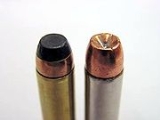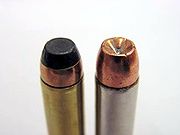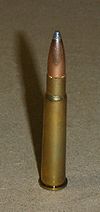
Soft point bullet
Encyclopedia



Lead
Lead is a main-group element in the carbon group with the symbol Pb and atomic number 82. Lead is a soft, malleable poor metal. It is also counted as one of the heavy metals. Metallic lead has a bluish-white color after being freshly cut, but it soon tarnishes to a dull grayish color when exposed...
expanding bullet with a copper or brass jacket that is left open at the tip, exposing some of the lead inside and is thus an example of a semi-jacketed round. Side by side comparison with a hollow-point bullet and FMJ ammunition will quickly illustrate the difference.
After the introduction of cordite
Cordite
Cordite is a family of smokeless propellants developed and produced in the United Kingdom from 1889 to replace gunpowder as a military propellant. Like gunpowder, cordite is classified as a low explosive because of its slow burning rates and consequently low brisance...
as a propellant it was noted that lead bullets fired at the higher velocities cordite allowed were readily stripped as they travelled along the barrel. This led to significantly faster fouling of the barrel as lead deposits built up particularly on rifled barrels. Bullets were jacketed
Full metal jacket bullet
A full metal jacket is a bullet consisting of a soft core encased in a shell of harder metal, such as gilding metal, cupronickel or less commonly a steel alloy. This shell can extend around all of the bullet, or often just the front and sides with the rear left as exposed lead...
to prevent fouling, although these inflicted less severe wounds. Partially jacketing the bullet allowed the bullet to foul the barrel less while also exposing the soft tip which is designed to expand upon impact and to spread open the harder metal jacket. The mechanism is the same as hollow-point bullets, but the lack of a hollow depression reduces the area upon which the hydraulic pressure can act on the lead, and thus the soft-point bullet expands more slowly than a hollow point.
Soft-point bullets are less common than hollow points, due to the slower expansion and greater penetration, but they fill roles that hollow points do not. In some cases the reduced expansion is desired, so that more penetration is achieved before the bullet begins the rapid deceleration caused by expansion. In other cases, the smooth, rounded profile typical of a soft-point bullet is preferred over the concave tip of a hollow point, because the latter tends to suffer failure to feed malfunctions in certain magazine-fed firearms. Many of the more modern magazine-fed firearms were expressly designed to feed hollow points reliably, but many older and military-derived designs were not. Many military firearm
Firearm
A firearm is a weapon that launches one, or many, projectile at high velocity through confined burning of a propellant. This subsonic burning process is technically known as deflagration, as opposed to supersonic combustion known as a detonation. In older firearms, the propellant was typically...
s, especially pistol
Pistol
When distinguished as a subset of handguns, a pistol is a handgun with a chamber that is integral with the barrel, as opposed to a revolver, wherein the chamber is separate from the barrel as a revolving cylinder. Typically, pistols have an effective range of about 100 feet.-History:The pistol...
s, were designed to fire only full metal jacket bullet
Full metal jacket bullet
A full metal jacket is a bullet consisting of a soft core encased in a shell of harder metal, such as gilding metal, cupronickel or less commonly a steel alloy. This shell can extend around all of the bullet, or often just the front and sides with the rear left as exposed lead...
(FMJ) ammunition, and will suffer failures to feed with hollow-point ammunition, leaving soft-point ammunition
Ammunition
Ammunition is a generic term derived from the French language la munition which embraced all material used for war , but which in time came to refer specifically to gunpowder and artillery. The collective term for all types of ammunition is munitions...
the best choice for non-military defensive purposes in these firearms. Military firearms are designed to use FMJ rounds because the Hague Convention
Hague Conventions (1899 and 1907)
The Hague Conventions were two international treaties negotiated at international peace conferences at The Hague in the Netherlands: The First Hague Conference in 1899 and the Second Hague Conference in 1907...
prohibits nations which are signatory to the convention from using expanding bullets in warfare. However, this convention does not apply to individuals in non-warfare situations, such as law enforcement, personal defense and hunting.
Jacketed soft point is usually abbreviated JSP in the ammunition and reloading industry. Jacketed flat point (JFP) is also used for soft-point bullets with a flat, rather than a rounded front. Until recently, flat-point bullets were required in centerfire rifles with tubular magazines, such as the Winchester rifle
Winchester rifle
In common usage, Winchester rifle usually means any of the lever-action rifles manufactured by the Winchester Repeating Arms Company, though the company has also manufactured many rifles of other action types...
, where the rounds are stored front-to-back. Use of metal-pointed bullets in these rifle
Rifle
A rifle is a firearm designed to be fired from the shoulder, with a barrel that has a helical groove or pattern of grooves cut into the barrel walls. The raised areas of the rifling are called "lands," which make contact with the projectile , imparting spin around an axis corresponding to the...
s can be highly dangerous, as the point of the bullet will rest against the primer
Percussion cap
The percussion cap, introduced around 1830, was the crucial invention that enabled muzzleloading firearms to fire reliably in any weather.Before this development, firearms used flintlock ignition systems which produced flint-on-steel sparks to ignite a pan of priming powder and thereby fire the...
of the round in front of it and can cause a detonation under the force of recoil
Recoil
Recoil is the backward momentum of a gun when it is discharged. In technical terms, the recoil caused by the gun exactly balances the forward momentum of the projectile and exhaust gasses, according to Newton's third law...
. Since late 2005, newer bullet designs with polymer tips offering improved ballistics have become available for safe use in tubular magazine rifles.

